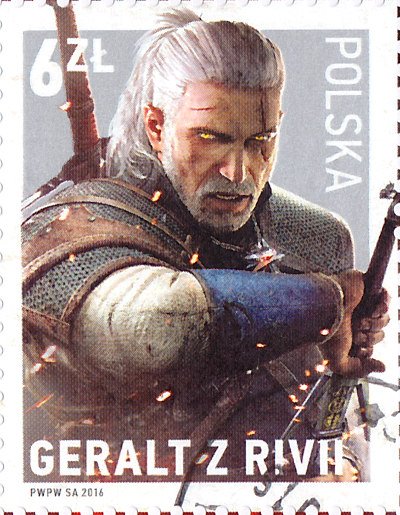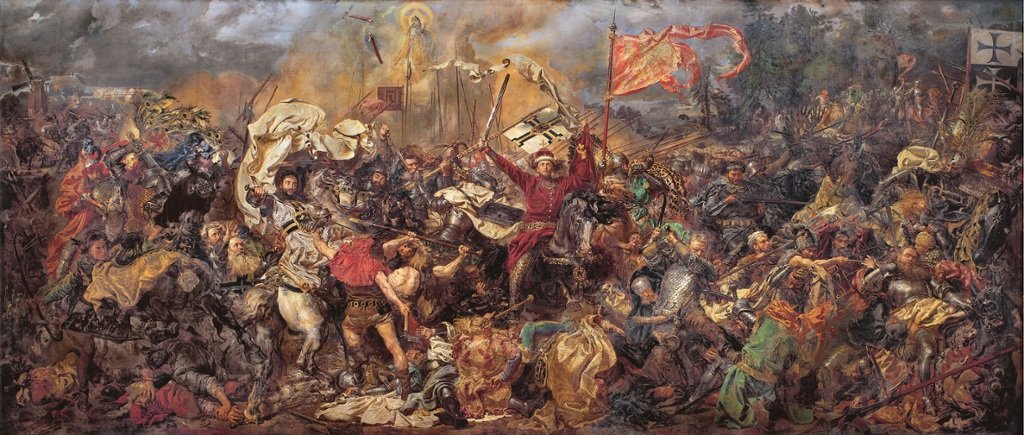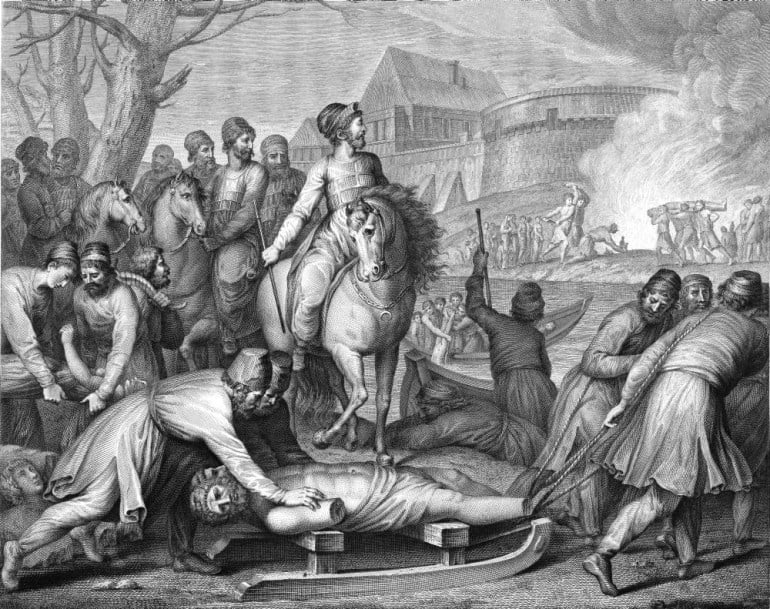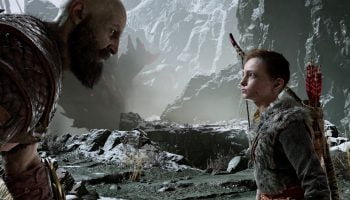The Witcher is a series of multiple award-winning medieval fantasy role-playing games for PC and consoles. Unlike many other fantasy role playing games, often developed by American or large international companies, The Witcher is distinctly Polish. It was developed by Polish game development company CD Projekt (which began small but, with the success of the game has grown significantly). It is based on a popular series of books of the same name by Polish author Andrej Sapkowski.
But gamers were not the only ones to take notice of the series: The Witcher games have attracted notice from very high places. During a diplomatic trip to Poland in June of 2014, Barrack Obama had a bit to say about the game:
The last time I was here, Donald [Tusk] gave me a gift, the video game developed here in Poland that’s won fans the world over, “The Witcher.” I confess, I’m not very good at video games, but I’ve been told that it is a great example of Poland’s place in the new global economy.
While Obama praised the series on the basis that it signalled the flourishing of Poland’s post-Cold War technology industry, it has a more symbolic meaning for its Polish developers. In response to Obama’s comments, Adam Badowski (then-director of The Witcher 2), issued this statement:
This is an extraordinary acknowledgement of our hard work here at CD Projekt Red. The Witcher 2 is a game we created for players around the world by drawing from various sources including our national heritage. We are truly pleased to promote our culture in this manner.
The developers of The Witcher series clearly sought to invoke a romanticized perception of the nation’s past to perpetuate a particular cultural identity. In doing so they created a cultural artifact that can be recognized both locally and internationally as ‘Polish’. Their vision of Poland is defined by a broad pan-Slavic cultural heritage, rather than adhering to a narrower nationalist (racially homogenous and Catholic) ideal. Leaning on these historical and cultural traditions has provided a rich source base for an immersive series which articulates a new interpretation of Polish history and culture in the post-Cold War era.
This vision of Poland stands against a rising tide of far-right Polish nationalism and appropriation of the past by extremist groups. Poland is but one of the many states across Europe undergoing a nationalist revival and the construction of a unique Polish identity in The Witcher series has emerged as another conflict in this ongoing cultural war.

The Witcher Basics
As mentioned The Witcher games are based on the successful fantasy book series by Andrzej Sapkowski. Although the games have received important and considered criticism for their absence of black characters and a lack of female agency, many players and critics celebrate the series for how it represents Polish folklore and culture. Its worldwide popularity is a testament to this. The trilogy of games sold an impressive 33 million copies between 2007 and 2017. The Witcher franchise has only grown in popularity over time, with the third installment now hailed by many as one of the greatest open-world games of all time.
The series follows Geralt of Rivia, a hunter-for-hire of supernatural monsters (known, in this world, as ‘witchers’. Witchers are capable of supernatural abilities, trained to combat beasts and the other dark forces that plague the lands. They are subjected to alchemical processes and gene-modifying substances, setting them physically apart from the other inhabitants of this fantasy realm. These supernatural abilities, combined with their itinerant lifestyle, and status as outsiders mean that witchers are viewed with suspicion by the general population.
The lore and characterisation of witchers draws on European folklore, referencing figures such as cunning folk, white witches/wizards, or magi. Like Geralt, these individuals were healers, diviners, or repositories of local knowledge, sought out for their magical charms until (more often than not) the local community turned on them for some real or imagined indiscretion.
The History and Mythology of The Witcher
The Witcher games take place in the quasi-medieval ‘Northern Kingdoms’, a collection of states set on ‘The Continent’. The majority of the population is human but the standard fantasy races of elves, dwarves, halflings, and gnomes are also present alongside numerous more-fantastical monsters. On the surface, the series ticks all the boxes for generic Western European fantasy.
However, despite surface similarities to games like Skyrim and Dragon Age, The Witcher draws on rather different source material. Instead of the more typical Arthurian, French, Germanic, or Nordic influences, the Northern Kingdoms are based primarily on a mythological pan-Slavic vision of Central Europe.
The Witcher draws from the political history of medieval Poland and its neighbouring states. The kingdom of Redania, a major power throughout the series, bears a crest that is nearly identical to the Polish coat of arms. Other powers in-game draw clear inspiration from the region: Nilfgaard leans heavily on the medieval the Holy Roman Empire (in, more or less, modern-day Germany), while the nation of Skellige is clearly inspired by Scandinavia.
But it’s the source material behind The Witcher’s portrayal of the fantastic which really sets it apart from most RPGs. The game’s rich world is intertwined with the supernatural realm. But instead of generic orcs and goblins, the player is beset by creatures and monsters drawn from Slavic and Eastern European folktales. These creatures include the Leshen, based on the Leshy or Leszt; a shapeshifting forest deity that can command plants and animals. Also appearing are the Noonwraiths, inspired by the Poludnica; a spirit that manifested in fields as a swirling vortex on windless days and killed workers who failed to take shelter from the harsh midday sun. There’s a diversity and depth here which is rarely found in the game’s competitors.

More Than a Different Setting
The Witcher is not just an innovative setting though. Its engagement with Slavic and Eastern European traditions is an invocative expression of modern Polish cultural identity.

The franchise has become one of Poland’s best known cultural exports. Numerous renowned Polish actors, including Jacek Rozenek and Anna Cieslak, have been cast as voices in the games. The series has been adapted for TV and film twice already, with an international Netflix series set to release by the end of 2019. Geralt even has a national stamp. Marcin Iwinski, the co-founder of CD Projekt, has explicitly stated that The Witcher universe stands as “a tribute to the Polish language and to Polishness in general”.
CD Projekt and its subsidiaries are one of the success stories of the Polish gaming industry, which is now one of the biggest in Europe. They have achieved this feat by embracing their own cultural experiences, crafting a world which builds on the conventions of Western fantasy while tempering this with the sensibilities of Slavic folklore. The Witcher is very much a Polish game, shaped by Polish history and a broader conception of pan-Slavic heritage.
Polish Nationalism
The creators of The Witcher are not the only ones to make use of this cultural heritage. The series was developed during a period of historical revisionism in Poland. Nationalist movements have swept across Europe in the past decade; The Witcher’s attempt to articulate a cultural identity has emerged within this increasingly contested polemical space.
Polish nationalism has its origins in the late 18th century following the dissolution of the Polish-Lithuanian Commonwealth and the subsequent partitioning of Polish lands by foreign powers. Nationalist sentiments were suppressed, to a certain extent, through incorporation within Communist doctrine during the Cold War. But, they have been reignited in recent years. The emergence of a Polish nationalist movement has intensified since the right-wing populist Law and Justice Party (PiS) were swept into power in 2015 on the back of an anti-migration and pro-nationalist campaign. The last few years have also seen a surge in activity by Polish far-right militant nationalists.

These nationalist groups frequently draw on the rhetoric and iconography of 19th and 20th century nationalist movements. They employ many of the same historical and cultural influences used in The Witcher to configure Poland as a homogenously white state and so justify the exclusion and expulsion of ‘non-Poles’ from their nation.
The Polish nationalist movement is committed to an ethno-centric Catholic Poland: one that, they believe, can act as a bulwark against the perceived threats of ‘cultural Marxism’ (a snarl word used to paint all progressives as part of a vast communist and/or Jewish conspiracy) and Islam. During a November march in 2017 chants like “Europe Will Be White” and “Not red, not rainbow but national Poland” could be heard from the crowd. As far-right and populist political parties take power across Europe, rhetoric such as this has become more common and far more bold.
Same Sources, Different Arguments
But while nationalist groups and the developers of The Witcher series draw on similar historical and cultural sources, their goals and approaches are substantially different. Where the nationalists use this cultural heritage to divide and persecute, CD Projekt Red use it to reflect upon the injustices of Polish and Slavic history.
The non-humans in The Witcher games are treated as second class citizens, a clear reference to the treatment of many groups throughout history. For instance, in one of the quests from The Witcher called “Racists”, Geralt comes upon a dwarf – named Zoltan – being tormented by humans in a fishing village. The attackers are attempting to shave off Zoltan’s beard and can be heard delivering insults like: “Hands off human women, dwarf!” and “Send him to a reservation!” Fending off the mob earns the player Zoltan’s thanks and some experience points needed to unlock new skills and powers. This amounts to an explicit condemnation of racial oppression through both game narrative and game mechanics.
This quest invokes numerous historical episodes, particularly the treatment of Polish Jews who were publicly assaulted (and shaved) under the Nazi occupation. The game developers present a world and story which bears many striking parallels with medieval Poland but use this world to discuss recent and contemporary racial and political tensions. In stark contrast with the rhetoric of Polish far-right nationalists, The Witcher series uses the past to decry the persecution of outsiders.
Unity or Fracture?
Today’s Polish nationalists often emphasise the supremacy of their state on a territorial basis. Up until the 18th century, Poland exercised control over a vast territory in Eastern Europe. Modern nationalists use these historical borders as the basis for claims over parts of Ukraine, Belarus, Lithuania, and the Czech Republic.
These historical borders were those of the Polish Lithuanian Commonwealth, from the 16th to the 18th century. During this time, the Commonwealth imagined itself as a beacon of civilization, and treated Poles as culturally superior to the other various ethnicities that lived within its borders. This notion of Polish superiority informs modern Polish nationalism: Poland is presented as a natural territorial unit extending well beyond its current borders, unified through its shared (and supposedly superior) culture, history, and heritage.

In contrast, the Northern Kingdoms of The Witcher are a fragmented and turbulent region. This pseudo-Poland is based more closely on the divided Polish duchies of the 12th and 13th centuries than the early modern Polish-Lithuanian Commonwealth. While resistance to outside invasion is a major theme within the games, the unification (or conquest) of The Witcher’s Northern Kingdoms is a goal only pursued by the most megalomaniacal of the kings in the game. The powerful Nilfgaardian Empire is a consistent and powerful antagonist with its xenophobic attitudes and imperialistic aspirations on full display. This is an implicit indictment of the rhetoric of many modern-day nationalists.
Catholic or Pagan?
Modern Polish nationalist identity is often closely linked with Roman-Catholicism. Following the lead of 18th and 19th century Polish writers, these modern nationalists reconstruct the history of Poland within a tight Roman-Catholic model. This is an attempt to align their movement with a broad unifying characteristic within Poland: at present 87.2% of Poles identify as Catholic.
Furthermore, this link to Catholicism allows nationalists to claim a historical legacy for their movement, stretching back to the baptism of King Mieszko I (the first King of Poland) in 966. Through this, Polish nationalists frame medieval Poland as a religiously homogenous Catholic state.

The Witcher presents a very different image of religion in the Northern Kingdoms and, by extension, in Poland. A range of different deities are worshipped throughout the region. A pantheon of gods drawn from Norse mythology rub shoulders with powerful spirits influenced by Slavic culture and a monotheist religion based on the Roman Catholic Church. Far from the monolithic unifying factor presented by modern nationalists, the religion of the Northern Kingdoms is diverse and rich. The developers of The Witcher present Polish cultural identity as incorporating Slavic folklore and traditions, rather than excluding it.
This interpretation is drawn from the diverse religious practices in Poland through much of the Middle Ages. The Christianization of Poland was a lengthy process and was accomplished from the top-down. Mieszko and the ruling classes may have converted in 966 but pagan beliefs survived and co-existed with Christianity for many centuries. Even in the modern world, the ‘pagan’ folklore of Poland remains intertwined with the predominantly Catholic identity of the Polish people.
In fact, The Witcher presents a fairly negative view of Christianity. The monotheist ‘Church of the Eternal Fire’ in the game draws heavily on Christian doctrine, symbolism, and tropes. In the city of Novigrad the Church exerts complete power, led by the pope-like figure named Hierarch Cyrus Engelkind Hemmelfart. The Church considers all sorcery as inherently evil and labels non-humans and supernatural creatures as its enemies.
The atrocities committed by The Eternal Fire and their followers have strong parallels with the darkest deeds committed in the name of the Catholic Church against religious and social outsiders. This amounts to a critique of Roman Catholicism’s historical role in Central Europe, particularly as this is a fantasy setting where other deities and supernatural creatures are actually present. In the Witcher games we see the effects of religious oppression and persecution from the point of view of its victims. The Church of The Witcher is not a unifying nationalist force for good, but a divisive and destructive power.
Polish Romanticism
The Witcher and contemporary Polish nationalists share a further set of historical source material and ideology: that of the Polish Romantics.
European Romanticism was an artistic and intellectual movement that emerged during the late 18th century. It was first conceived by figures like Johann Wolfgang von Goethe and Edmund Burke as a rejection to Enlightenment ideals of scientific and social progress. Seeing the mass poverty and disruption caused by the agricultural and industrial revolutions and the horrors of political revolutions in France, America, and elsewhere, the Romantics sought to return to a simpler and, in their eyes, ‘better’ time. The movement revolved around the central themes of venerating the natural realm, embracing emotional forms of piety, and reviving an idealised form of medievalism.
Later Romanticism developed powerful nationalist sentiments as it elevated folk customs to primordial markers of cultural and national identity. Romantic nationalism proved fundamental to many ethnic groups in 19th century Europe without an established nation state.

In the case of Poland, Romantic nationalism was the ideology through which a proto-form of national identity was constructed. The writings of Polish Romantics such as Adam Mickiewicz, Juliusz Słowacki, and Zygmunt Krasiński—Poland’s ‘Three Bards’ (Trzej Wieszcze)—were instrumental in this movement and laid the foundations for the ideology of the modern Polish state. All three of these individuals worked in exile during the Partitions of Poland and their texts underlined sentiments of Christian martyrdom, Polish independence, and resistance to foreign powers. They invoked Poland’s past and envisioned a glorious future for the nation, drawing on a mythologized view of the Polish people. In doing so, the Polish Romantics naturalized and appropriated many Slavic traditions and folktales, thereby inventing a Polish cultural identity that was actually pan-Slavic in nature.
Modern Polish nationalist groups draw on these ideals, but direct them towards the construction of an aggressive national identity. The Three Bards are central to the Polish literary canon and, by perverting their political sentiments, far-right nationalists claim legitimacy for their ideology.
Where the Polish Romantics rallied against the annexation of Polish territory by militarily superior foreign powers, modern nationalists use the same rhetoric to decry the perceived influx of refugees from war-torn countries or the proliferation of what they call ‘non-Polish’ cultural values. Modern Polish nationalism uses the language and imagery of romanticism to demand the protection of supposedly ‘Polish values’ against invading forces. But where the invading enemies of Romantic Poland were the Great Powers of the 18th century, today’s nationalists seek to paint vulnerable and ostracized outsiders, religious minorities and refugees, with the same brush.
The Witcher series often references Romantic figures and invokes Romantic imagery. For example, during a quest called “The Heat of the Day”, Geralt and his companion Dandelion are tasked with calming a restless spirit. This quest involves a marriage, sordid love affairs, and an impassioned murder: all conventional elements of European Romantic literature. At one point, Dandelion even recites lines taken verbatim from Mickiewicz’s The Ghost (Upior), a work that presents Slavic folklore as central to the Polish national identity.
As this literary allusion illustrates, and Iwinski acknowledges, CD Projekt Red have used Romantic ideals in The Witcher as a means of shaping perceptions of Polish cultural identity. The developers of The Witcher series followed in the footsteps of the Polish Romantics by drawing on broader elements of European, especially Slavic, folklore and traditions and defining these as Polish.
The significance of folklore in The Witcher is displayed clearly through the supernatural forces that the player encounters as Geralt. Many of these creatures like the Leshen and the Noonwraiths still retain their pre-Christian nature, existing as raw personifications of nature, driven by their primordial desires. But unlike many western European role-playing games which demand that their audience exterminate such monsters, The Witcher generally gives the player the option to leave these creatures in peace. In fact, many of the better story and material outcomes to quests are achieved by allowing these monsters to live.
The game embraces a neo-pagan worldview where monsters and folktales are central to culture, not evil outsiders to serve as sword-fodder for the player. This game mechanic promotes acceptance of different ethnicities and belief systems, a sharp contrast with the rhetoric presented by the Polish nationalists. The two interpretations of Romantic ideology differ massively despite originating from the same source material.
A Different Model of Cultural Identity?
Against a groundswell of Polish nationalism, The Witcher series stands out for the type of cultural identity that it promotes. In shaping the fantasy world of The Witcher, CD Projekt Red drew on Romantic perceptions of medieval and pre-Christian Polish history, basing their narratives in the dark nature of Slavic folklore. While other game series like Mount and Blade also draw on historical perceptions of Central and Eastern medieval Europe, The Witcher is underlined by a far more ideological conception of cultural identity. The supernatural creatures depicted in these games are personifications of a romanticised Polish heritage, one that invokes the spirit of Slavic folklore. The great achievement of these games is how they bring the supernatural elements of these folktales to life, claiming these creatures as uniquely Polish. The Witcher games follow in the traditions European Romantics: proclaiming folklore as a primordial expression of the Polish identity.
In drawing on a Romantic interpretation of Polish cultural identity The Witcher comes into conflict with the far-right interpretation of Polish national identity constructed in the past few decades. While both models employ Romantic nationalist rhetoric to define what is Polish, there are fundamental differences between their conclusions. Nationalist groups push an ideology in which Poland exists as a historically homogenous Catholic state with clearly defined cultural traditions. The Witcher presents a broader pan-Slavic interpretation of Poland in which the boundaries between Slavic and Polish traditions are decisively blurred. Both models, while in conflict, are evident of an overarching movement in which the Polish people are actively attempting to redefine their culture and identity in the wake of the Cold War.
The future of Poland is being actively determined by revisionist interpretations of its past and, as the last few years have shown, it is the voice of the far-right nationalists that is the loudest. In this contested space, The Witcher series, despite its shortcomings, is an important and potentially influential counter.
If you enjoyed that article, please share it with your history-loving friends on Facebook, or on Twitter! And be sure to subscribe here to receive every new article from The Public Medievalist the moment it launches.





